A stroll around La Baronia de Rialb
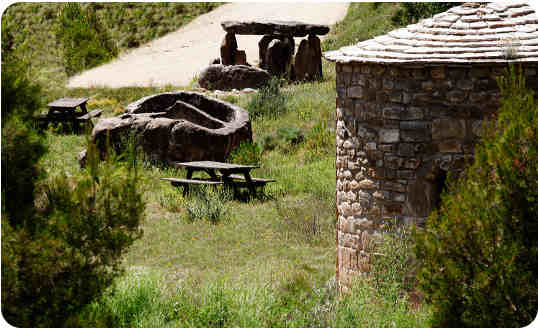 Tres Pilars Dolmen
Tres Pilars Dolmen
Prehistoric...
 Sols de Riu or the Tres Pilars Dolmen de la Torra
Sols de Riu or the Tres Pilars Dolmen de la Torra
Funeral construction from the Eneolithic period or start of the metal age. It is a typical megalith made of large vertical stones; the entrance to the funeral monument is on the northern side, where a sgraffito drawing can be made out. Dwellers of caves and of shepherds’ huts built dolmens, which bear testimony to the worship and veneration of the dead.
Location: In the direction of Tremp, at the crossroads (km 5.6) of the C1412b. Dolmen area.
Information and visits: free visit. (See attached information).
Romanesque...
Monastery of Sta. Maria, 12-13th
This church dates from the twelfth-thirteenth century. It is currently being restored as it was destroyed by a gunpowder explosion in 1939 at the end of the Civil War.
The church is a building with three naves, a large greater apse and two lateral apsidal chapels. The central nave was covered by a slightly pointed barrel vault, which rested on three reinforcing ribs, while the three lower side naves had a barrel vault. The crossing projected slightly from the walls and gave way to an octagonal dome base, which covered the space in the transept with a dome on squinches.
Location: C/ Monastery, 1. Before the nucleus of Gualter and 1 km from Ponts.
Information and visits: free visit and guided visit. (See attached information)
Hermitage of Sta. Eulàulia de Pomanyons in La Torra, 11-12th
Single-nave church, covered with a semicircular barrel vault and closed on the east with a semicircular apse, preceded by a narrow presbyterial section. The door keeps to the interior arch perfectly. It was moved as it had been affected by the water level in the Rialb Reservoir.
Location: In the direction of Tremp, crossroads (at km 5.6) on the C1412b. Dolmen area.
Information and visits: free visit. (See attached information)
Hermitage of St. Girvés de la Torra, 11th
Basilica structure church with three naves covered with semicircular barrel vaults. The door, which features a semicircular arch, still conserves the threshold, which shows signs of opening and closing and no ornamentation. There remain the original eaves, taken from the apse, where there are still some very damaged fragments of decoration, which comprises a frieze of Lombard arcature.
Location: In the direction of Tremp, crossroads (at km 5.6) on the C1412b. Dolmen area.
Information and visits: free visit. (See attached information)
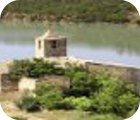 St. Iscle i Sta. Victòria de la Torre, 10-11th
St. Iscle i Sta. Victòria de la Torre, 10-11th
This building is a highly exceptional example of early medieval Catalan architecture, the features of which suggest a work from the eleventh century as it strays from the dominant trends of the period in which it was made. It may nonetheless date from an earlier time: between the tenth century and the start of the eleventh century.
Location: in the direction of Tremp, Politg crossroads. La Torre.
Information and visits: free visit and guided visit (See attached information)
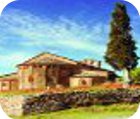 Santa Maria de Palau, 11th
Santa Maria de Palau, 11th
It belonged to the priory of Santa Maria de Meià from the eleventh century. The building has recently been restored and distinguished, particularly the western sector where the rector’s house was adjoined, which led to significant alterations on this façade. It coincides fully with the forms of eleventh-century Lombard architecture. The decoration of the façades is accomplished with great compositional rigour and is only altered in the main apse, where the central window interrupts a lesene, which is the result of an error in the distribution of the ceilings and their distribution with regard to the windows.
Location: In the direction of Tremp, crossroads at km 18 of the C1412b.
Information and visits: free visit and guided visit. (See attached information).
Sant Serni de Bellfort, 11th
This building has been completely transformed, so much that the façade of the apse is the only element that suggests its early medieval origin and also constitutes the most interesting part of the church. The building is very irregular, which reveals the typical forms of eleventh-century.
Location: In the direction of Tremp, on the other side of the Politg crossroads.
Information and visits: free visit.
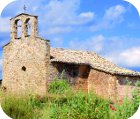 Sant Miquel de Vilaplana, 11-12th
Sant Miquel de Vilaplana, 11-12th
Romanesque church from the eleventh-twelfth centuries. Its location in a castle suggests a relatively early construction. This parish covers a large area that runs from the Segre to the municipality of Pallerols and Peramola.
Location: In the direction of Tremp, Politg crossroads, towards Vilaplana.
Information and visits: free visit and guided visit. (See attached information)
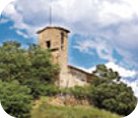 Sant Andreu del Puig, 11th
Sant Andreu del Puig, 11th
There were two parishes in the Middle Ages: Rialb Sobirà and Rialb Jussà. The former, Rialb Sobirà, was identified with Sant Andreu del Puig. Although this church reported to the parish of Sant Martí de Tarabau, it subsequently recovered the parish and Sant Martí de Tarabau became its suffragen church. This situation persevered until the twentieth century. Its ornamental nature, which differs from more typical models of Lombard decoration, suggests it is from the late eleventh century or perhaps even the twelfth century.
Location: In the direction of Tremp, Puig and St. Cristòfol crossroads.
Information and visits: free visit.
Sant Jaume de Sant Cristòfol de la Donzell, 11th
Romanesque type church built in the late eleventh century and early twelfth century. Although it is practically in ruins, it still retains enough elements to reveal its original architectural quality and its highly ambitious design.
Location: in the direction of Tremp, crossroads at Puig i St. Cristòfol.
Information and visits: free visit.
Sant Martí de Terrassola, 11th
During the Middle Ages it was the religious centre of the upper zone of the Rialb valley, mentioned in medieval documentation as the " Tarabau valley ". Despite the questions raised by the current ruined, abandoned state of the church, it is clear that this building was constructed in two phases. It was adapted in the eleventh century to the evolved forms of Lombard architecture. The development in construction of the church of Sant Martí is very similar to that of the church of Sant Sebastià de Cerdanyés.
Location: In the direction of Tremp, Puig and St. Cristòfol crossroads.
Information and visits: free visit.
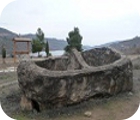 Outdoor stone cisterns in Mas Pomanyons de la Torra, 10-11th
Outdoor stone cisterns in Mas Pomanyons de la Torra, 10-11th
These cisterns were joined to the Pomanyons Tower (which no longer exists) and were part of its defensive unit and that of the hermitage of Sta. Eulària. They were used to store rainwater using a slope system and, when rainwater was scarce, they stored the scant water from the river.
Location: In the direction of Tremp, crossroads (at km 5.6) on the C1412b. Dolmen area de la Torra.
Information and visits: free visit.
Other periods...
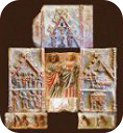 Altarpiece of Sant Iscle and Santa Victòria de la Torre de Rialb
Altarpiece of Sant Iscle and Santa Victòria de la Torre de Rialb
It was originally located by the main altar of the former parish church of Torre de Rialb. It is a polychrome sculpture group in triptych format. Divided into six scenic registers and a lower bench, or predella, sculpted in high relief; with scenes from the life and the passion of Sant Iscle and Saint Victoria, supposed martyrs from Cordoba in the fourth century A.D.
Location: Politg. In the direction of Tremp, Politg crossroads.
Information and visits: free visit and guided visit. (See attached information)
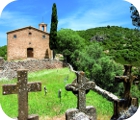 Sant Esteve de Pallerols
Sant Esteve de Pallerols
The building today is the result of intense alteration work undertaken in 1793. In its current condition it is difficult to establish the original structure, although it is likely to have had a single, extended nave. The appearance of the early medieval remains is very uniform, despite the lack of ornamentation.
Location: It is located in the small, abandoned hamlet of Pallerols de Rialb, which lies on the municipal boundaries of Peramola and Gavarra. In the direction of Tremp, by the Politg crossroads.
Information and visits: free visit and guided visit. (See attached information)
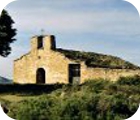 Sant Pere Soler, 14th
Sant Pere Soler, 14th
Although there are no documentary records on this chapel from before 1300, to a larger or lesser extent worship has always taken place here. It was and still is a church very closely associated with the owners of Soler, who have documentation from the early fourteenth century. The church is a very simple building and clearly appears to have been renovated.
Location: in the municipality of Mas del Soler, continuing along the Pallerols track, some two hundred metres above El Mas.
Information and visits: free visit.












